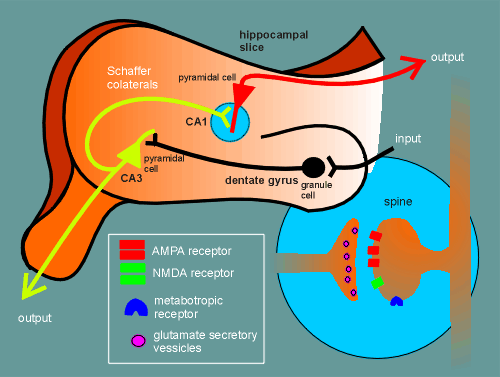 The rat hippocampus is perhaps the most studied piece of
brain tissue in the world.
The rat hippocampus is perhaps the most studied piece of
brain tissue in the world. The rat hippocampus is perhaps the most studied piece of
brain tissue in the world.
The rat hippocampus is perhaps the most studied piece of
brain tissue in the world.
The hippocampus is an ancient part of the brain which receives input via the dentate gyrus.
Granule cells of the dentate gyrus regulate the activity of pyramidal cells of the so-called CA3 region, which in turn regulate, via Schaffer colaterals, the activity of pyramidal cells of the CA1 region.
 Within the hippocampus, the CA1 region is the most extensively
studied.
Within the hippocampus, the CA1 region is the most extensively
studied.
Why? .... because it is used, worldwide, as a model to study synaptic plasticity...the ability of synapses to change strength (to become stronger or weaker).
The pyramidal cells of the CA1 region are believed to be involved in learning and memory processes and thus they show considerable plasticity.
It is relatively easy to work electrophysiologically with the CA1 pyramidal cells.
Their cell bodies are quite large and easily patched in hippocampal slices to record postsynaptic potentials.
Stimulating electrodes can be used to activate the Schaffer colaterals and thus synaptic communication can be studied.
The Schaffer colaterals contain glutamate as neurotransmitter and they synapse on spines of the pyramidal cell dendrites.
Post-synaptically it has been demonstrated that there are glutamate AMPA receptors, NMDA receptors and metabotropic receptors for glutamate.
Thus, the CA1 region is a good place to study the functioning of different types of glutamate receptors.